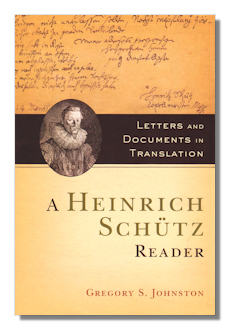
The Internet's Premier Classical Music Source
Related Links
-
Introduction
Acoustics
Ballet
Biographies
Chamber Music
Composers & Composition
Conducting
Criticism & Commentary
Discographies & CD Guides
Fiction
History
Humor
Illustrations & Photos
Instrumental
Lieder
Music Appreciation
Music Education
Music Industry
Music and the Mind
Opera
Orchestration
Reference Works
Scores
Thematic Indices
Theory & Analysis
Vocal Technique
Search Amazon
Recommended Links
Site News
 Book Review
Book Review
A Heinrich Schütz Reader

Letters and Documents in Translation
Gregory S. Johnston
Oxford University Press, USA, 2013 pp xxviii + 283
ISBN-10: 0199812209
ISBN-13: 978-0199812202
Gregory Johnston is Associate Professor of Musicology at the University of Toronto. He has written a book that may – at first sight – seem to be of limited (or somewhat specialized) appeal. It's a collection of primary sources by, to and about Heinrich Schütz (1585-1672). Yet if you remember just how important and influential Schütz was, the book's potentially wider appeal ought to be more apparent. If you then acknowledge the insight which biographical, contextual, historical and musicologically relevant texts can offer – especially in the case of an œuvre and life four hundred years ago – the appeal grows still further. Lastly, when you know that the job of selecting, translating and assembling this disparate primary material has been done as well as Johnston has done it, even the relatively high price of $60+ seems justified for the general reader. For the specialist this book must be thought of as essential.
A Heinrich Schütz Reader is not a long volume; at under 300 pages, though, it still affords an excellent insight into what Schütz achieved; how, to some extent why, he was viewed by his contemporaries. The latter, in turn, feeds back into our understanding of just how great a figure the composer was.
Not for nothing, you soon realize was Schütz called "the father of our modern music" and "the Orpheus of our time" by his (German) contemporaries. Johnston doesn't seem to have set out with the intention of augmenting the composer's reputation in any way. Nor of making claims that even casual listening to his music wouldn't prompt you to find plausible anyway. Yet the mere act of having assembled these documents necessarily and perhaps inevitably invites us to explore beyond the works; and so to gain a far greater understanding of Schütz's standing – especially because this collection brings him and his world so vividly to life.
Johnston's sources are both manuscript and print. They range from Schütz's "apprenticeship" with Giovanni Gabrieli to the former's death. They're German, Latin and Italian originals which Johnston has expertly translated. These sources are apparently often thickets of orthographic and/or typesetting obscurity. At times some of these are noted as of uncertain or even impossible explanation by the author – the letters "v.l.f.g.g.u.g.b." following a phrase on the title page of Schütz's "Musicalische Exequien" [p.96], for instance. That we now have the documents in completely accessible form, where they would otherwise be hard to read (let alone to find and otherwise identify) for the non-specialist, is in itself enough to recommend this book.
That the sources have been so well organized, annotated, cross-referenced and commented upon is an equally compelling reason to look seriously at A Heinrich Schütz Reader if the period, geographical areas and certainly the music of Schütz interest you. Specifically, each document is presented with textual glosses; provenance; dating; biographical and geographical contexts; suitably-informed speculation where necessary on competing resolutions for ambiguities; explanation of allusions; illumination of biblical, earlier and contemporary literary sources; even architectural trends and features of the decorative arts: ornamentation (palms) in a Dresden church [p.238], for example; bibliographical data that extends our understanding; and of course exhaustive reference to compositional history and entities.
In particular, what we would now call the "geopolitical" picture of Schütz's world was complex… regions, regions of (cultural) influence, patrons, would-be patrons, schools, fiefdoms, courts, institutions, traditions, and performance practices… the roles of Court musicians at Dresden (1617, [pp.16-21]). In addition to the "official" workings of these, there is much purely personal data – presumably how these personages all actually worked… Schütz's request to the Court at Wolfenbüttel [p. 123] for "clarification" on the availability and disposition of instrumentalists there, and so on.
The five pages of monochrome illustrations are grouped in the center of the book, which has no musical examples but a comprehensive bibliography, a glossary and thorough index. The layout of A Heinrich Schütz Reader is as one would expect for a scholarly, rather than narrative or publication of mass-appeal; though greater use of different font and weights would have made navigation easier… documents don't all begin on new pages. All 150 are grouped chronologically: Schütz's youth (1611-1627) which has the first 40 documents; middle age (1628-1644), 44; old age (1645-1656), 57; and last years (1657-1672), 22.
These sources are potentially scattered; they're certainly richly-disparate. The style of writing (…"Your Electoral Serenity's ever most humble, most obedient…" [p58] etc) was by convention so excessively obsequious – particularly when Schütz was writing to a patron or "master". Despite all of this, you soon learn to skip or filter. Then to enjoy what really is effectively a partial recreation of Schütz's life and world. Yes, this is an invaluable source for (specialist) researchers. But it's also uncommonly illustrative of the achievement of a still somewhat neglected and poorly-appreciated composer. Read it and you are more than likely to want to revisit his music; and in so doing get more from it than previously. Musicologically, A Heinrich Schütz Reader is a technical success. But its scope is sufficiently wide for the book to be both relevant and appealing to many constituencies other than musicologists.
Copyright © 2013 by Mark Sealey.


















